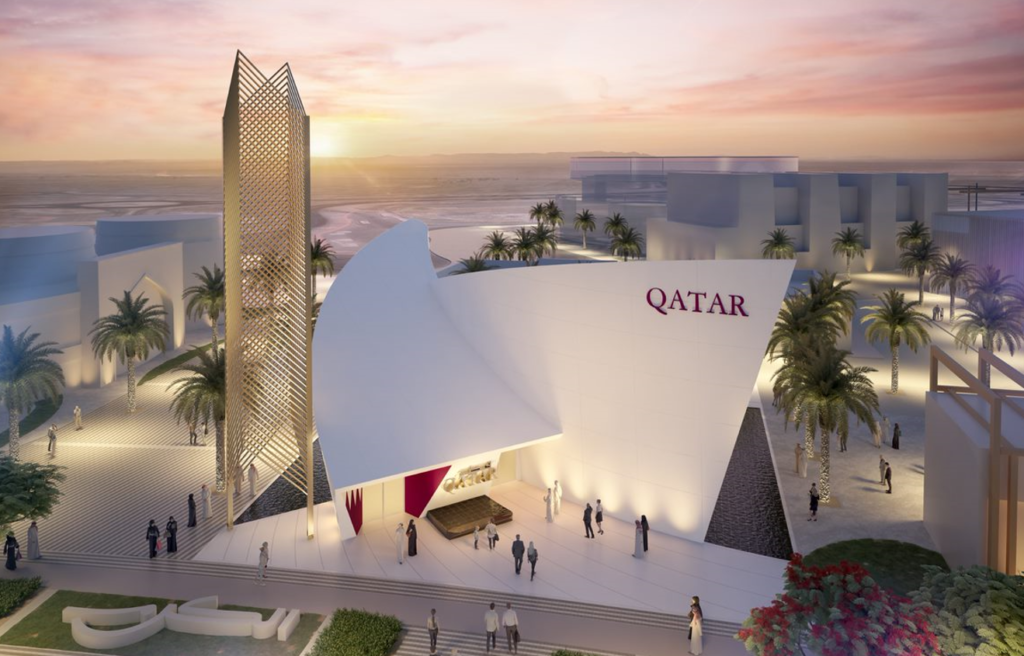Santiago Calatrava has unveiled the design for the Qatar Pavilion at EXPO 2020, fusing sculpture and structure to create an architectural beacon for Qatar’s pioneering vision of the future, while paying tribute to the nation’s rich cultural heritage.
The construction of the Qatar Pavilion, which is being carried out by Main Contractor, ALEC FITOUT, is already at an advanced stage and is expected to be completed next month. Given that the site works began in May 2021, the project represents a benchmark in efficient design and expeditious construction scheduling.
The Pavilion’s design draws inspiration from the four elements represented on the Coat of Arms of Qatar; two crossed and curved swords, encompassing a Dhow and Island with palm trees. The expressive form of the Pavilion eloquently combines and translates these cultural elements to capture movement, mobility, strength, and tradition. Calatrava’s design envisages a modern interpretation which symbolizes Qatar’s progressive outlook of the future while remaining true to its culture and heritage.
The Pavilion will take guests on an immersive experience through Qatar’s rich history and culture. Located within the sustainability district of EXPO 2020, the building is an architectural symbol, depicting a nation rising and transforming through a harmonious balance of Qatar’s traditional roots and innovative spirit.
Calatrava’s principal collaborators on the project are Aurecon, the multi-disciplinary engineer and design development, and ALEC FITOUT, the Main Contractor specialised in luxury fit-out and cultural immersive visitor experiences. The close collaboration, flexibility and open communication between all parties has facilitated the rapid design and construction progress which will culminate in an impressive construction period of just 5 months from start to finish.
The iconic, intersecting structures of the main building will ascend upwards to nearly 15 meters in height, with an adjacent sculptural monument rising at 20meters in height. Internally, the Pavilion will consist of two main galleries and exhibition spaces, providing highly engaging, inclusive, and experiential environments for visitors.
More on the design of the Qatar Pavilion
Calatrava’s philosophy is grounded in the belief that each innovative design must emanate from its cultural context, conveying traditional sensibility through modern architecture to create truly inspiring structures. Micael Calatrava, CEO of Calatrava International has described the design process for the Qatar Pavilion as follows:
“Inspiration is derived from Qatar’s national emblem to truly capture the essence and vision of the nation. The architectural gesture and structural form of the Pavilion, which houses the entire visitor experience, mirrors the shape of the Dhow and its grand sails. The sculptural monument at the entrance of the Pavilion represents an abstract translation and fusion of two intertwined Palm trees, while the reflective pools and integrated water features surrounding the Pavilion, represent the Arabian Gulf which encompasses the nation of Qatar.”
Once visitors enter the Qatar Pavilion, they are guided through an immersive experience whereby a deeply symbiotic relationship between the visual arts and the internal spaces engage, inspire and inform them about the past, present and future of Qatar.
Expedited Construction
Construction on the project is at an advanced stage and with the expedited schedule of five months, the Qatar Pavilion will be ready for the greatly anticipated opening of the Expo 2020 on October 1st, 2021.
Through dedication, hard work and close collaboration, the project team led by Micael Calatrava is able to apply an integrated design and accelerated construction strategy for the Qatar Pavilion at EXPO 2020. The approach follows a non-linear, non-traditional design methodology ensuring project delivery in a very aggressive timeline of 5 months.
In keeping with the architectural and engineering philosophy of Santiago Calatrava, the Qatar Pavilion is designed as a sustainable and functional structure, utilizing efficient processes which enable procurement and construction to proceed as the design develops. This approach facilitates fast-track project delivery and ensures all aspects of the design intent are preserved while ensuring the quality of erected works meet Client’s expectations.




